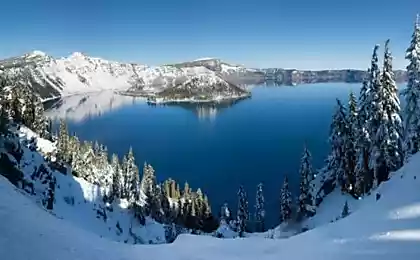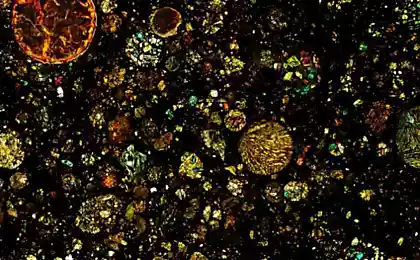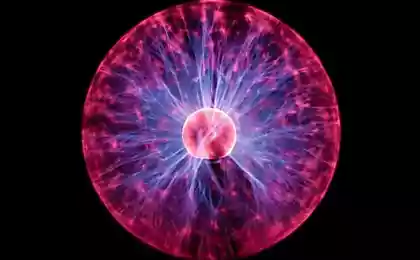1599
The deepest point in the world (12 photos)
Despite the fact that the oceans are closer to us than the distant planet of the solar system, the people investigated only five per cent of the ocean floor, which remains one of the greatest mysteries of our planet. The deepest part of the ocean - the Mariana Trench and the Mariana Trench is one of the most famous places, which we all know is not very much. When the water pressure, which is a thousand times greater than at sea level, immersion in this place is akin to suicide. But thanks to modern technology and a few brave individuals who risked their lives to go down there, we have learned many interesting things about this wonderful place.

Mariana Trench and the Mariana Trench is located in the western part of the Pacific Ocean to the east (about 200 km) from the 15-Mariana Islands near Guam. It is a crescent-shaped trench in the crust of a length of about 2550 km and an average width of 69 km.
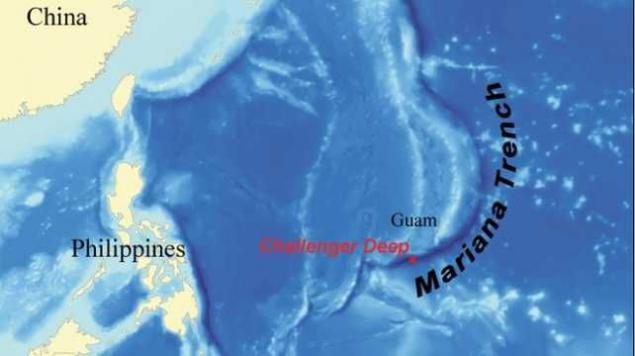
The coordinates of the Mariana Trench: 11 ° 22 'north latitude and 142 ° 35' east longitude.

According to recent studies in 2011 depth of the deepest point of the Mariana Trench is about 10,994 meters of ± 40 meters. For comparison, the height of the highest peak of the world - Mount Everest is 8848 meters. This means that if Everest was in the Mariana Trench, it would have been covered by another 2, 1 km of water.
Here are some other interesting facts that can be found along the way and at the bottom of the Mariana Trench.
1. Very hot water

Going down to such a depth, we expect that there will be very cold. The temperature here reaches just above zero, ranging from 1 to 4 degrees Celsius. However, at a depth of about 1, 6 km from the surface of the Pacific Ocean are hydrothermal vents called "black smokers". They shoot the water, which is heated to 450 degrees Celsius.
This water is rich in minerals that help maintain the life in this area. Although the temperature of the water, which is hundreds of degrees above the boiling point, the water is not boiling due to enormous pressure of water in 155 times higher than on the surface.
2. Giant toxic amoeba
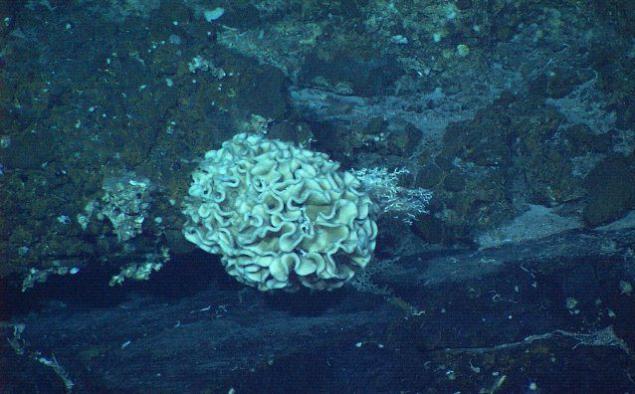
A few years ago at the bottom of the Mariana Trench discovered giant 10-centimeter amoebas called xenophyophore. These single-celled organisms may become so great because of the environment in which they are found at a depth of 10, 6 km. Cold temperatures, high pressure and a lack of sunlight, likely contributed to the fact that these amoebae gained enormous size.
In addition, xenophyophore has an incredible ability. They are resistant to multiple elements and chemicals, including uranium, mercury and lead that would kill other animals and people.
3. Shellfish

The strong water pressure in the Mariana Trench does not give a chance for the survival of any animal with shell or bone. However, in 2012, in the gutter near the serpentine hydrothermal vents were discovered mollusks. Serpentine contains hydrogen and methane, which allows you to create living organisms. How mollusks preserved its shell at a pressure remains unknown.
In addition, hydrothermal vents emit other gas - hydrogen sulfide, which is lethal to mollusks. However, they have learned to associate sulfur compounds in a safe protein that allowed the populations of these molluscs to survive.
4. Clean liquid carbon dioxide
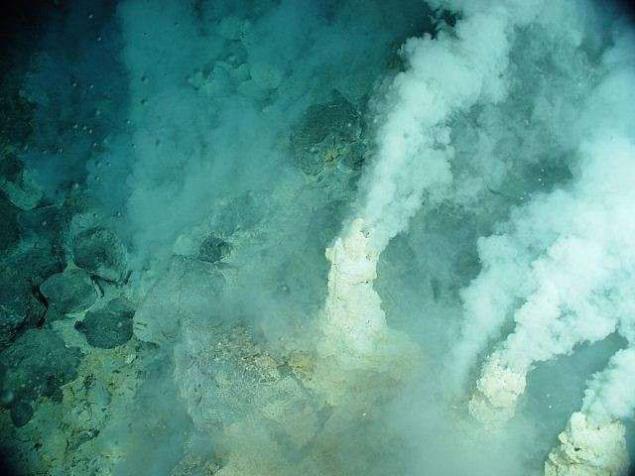
Hydrothermal vents Champagne Mariana Trench, which lies outside the trough of Okinawa near Taiwan, is the only known underwater area where you can find liquid carbon dioxide. Source, opened in 2005, was named in honor of the bubbles, which were carbon dioxide.
Many believe that these sources are called "white smokers" because of the lower temperature, it can be a source of life. It was in the depths of the oceans with a low temperature and the abundance of chemicals and power could harbor life.
5. Slime

If we were able to swim to the depths of the Mariana Trench, then we would feel that it is covered with a layer of viscous mucus. Sand, as we know it, there does not exist. The bottom of the trough consists essentially of residues of crushed shells and plankton, which sank to the bottom for many years. Because of the incredible water pressure, almost all there turns into a small grayish-yellow thick mud.
6. The liquid sulfur
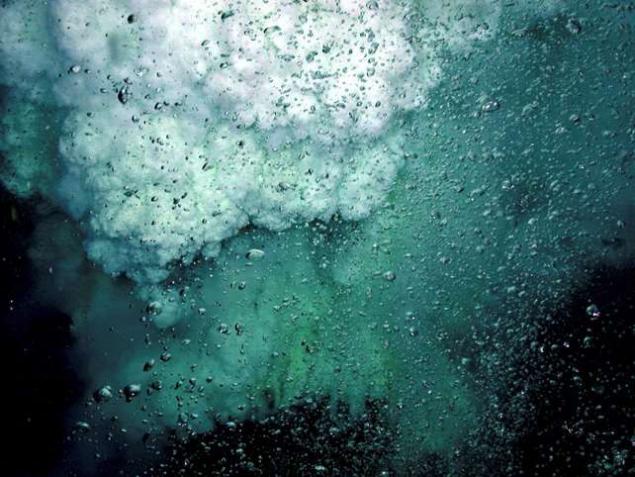
Daikoku Volcano, which lies at a depth of about 414 meters on the way to the Mariana Trench, is the source of one of the rarest of phenomena on the planet. There is a lake of pure molten sulfur. The only place where you can find liquid sulfur, a moon of Jupiter - Io.
In this hole, called "pot" boiling black emulsion boils at 187 degrees Celsius. Although scientists are not able to explore this place thoroughly, perhaps deeper contains more liquid sulfur. It can reveal the secret of the origin of life on Earth.
According to the hypothesis of Gaia, our planet is a self-governing body in which all the animate and inanimate is connected to sustain her life. If this hypothesis is correct, the number of signals can be observed in natural systems and cycles of the Earth. Since sulfur compounds by organisms in the ocean must be stable enough in the water to allow them to go into the air, and again return to the land.
7. Bridges

At the end of 2011 in the Mariana Trench was found four stone bridge that stretched from one end to the other 69 km. It seems that they were formed at the junction of the Pacific and Philippine tectonic plates.
One of the bridges Dutton Ridge, which was opened 1980, turned out to be extremely high as a small mountain. At the highest point of the ridge reaches 2, 5 km over the "Abyss Challenger." Like many aspects of the Mariana Trench, the purpose of these bridges is unclear. However, the mere fact that one of the most mysterious and unexplored places, they discovered the formation, is awesome.
8. James Cameron's dive to the Mariana Trench
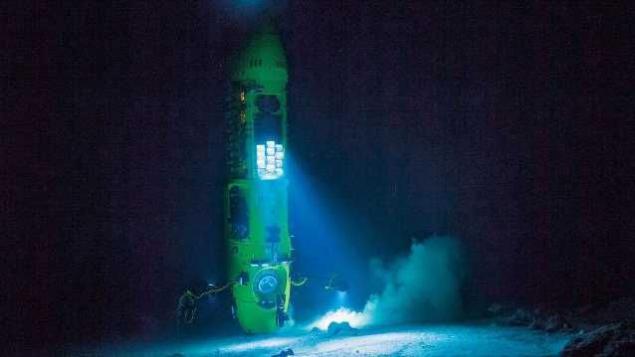
Since the discovery of the deepest place of the Mariana Trench - "Abyss Challenger" in 1875, it was visited by only three people. The first was the American Lieutenant Don Walsh and explorer Jacques Piccard, who made a dive January 23, 1960 aboard the "Challenger».
52 years here dared to plunge another man - a famous film director James Cameron. Since March 26, 2012 Cameron went down to the bottom and took a few photos. During the dive, James Cameron in 2012 to the "Abyss Challenger" on the submersible DeepSea Challenge, he tried to watch everything that happens in this place until mechanical problems forced him to rise to the surface.
While he was at the deepest point of the world ocean, he came to the shocking conclusion that he was completely alone. The Mariana Trench was not afraid of sea monsters or any miracles. According to Cameron the bottom of the ocean was "lunar ... empty ... lonely," and he felt "complete isolation from all mankind».
9. Mariana Trench
10. Mariana Trench in the ocean - the largest reserve
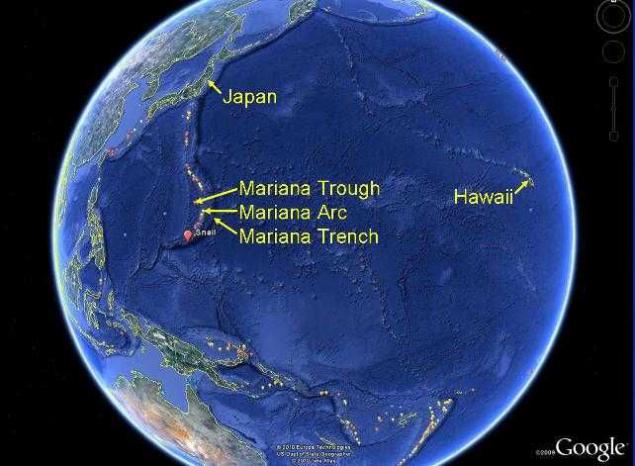
The Mariana Trench is the national monument of the United States and the largest marine reserve in the world. Since it is a monument, there are a number of rules for those who want to visit this place. Within its boundaries, fishing and mining are strictly prohibited. However, swimming is allowed, so you can be the next who will dare to go to the deepest place in the ocean.

Mariana Trench and the Mariana Trench is located in the western part of the Pacific Ocean to the east (about 200 km) from the 15-Mariana Islands near Guam. It is a crescent-shaped trench in the crust of a length of about 2550 km and an average width of 69 km.

The coordinates of the Mariana Trench: 11 ° 22 'north latitude and 142 ° 35' east longitude.

According to recent studies in 2011 depth of the deepest point of the Mariana Trench is about 10,994 meters of ± 40 meters. For comparison, the height of the highest peak of the world - Mount Everest is 8848 meters. This means that if Everest was in the Mariana Trench, it would have been covered by another 2, 1 km of water.
Here are some other interesting facts that can be found along the way and at the bottom of the Mariana Trench.
1. Very hot water

Going down to such a depth, we expect that there will be very cold. The temperature here reaches just above zero, ranging from 1 to 4 degrees Celsius. However, at a depth of about 1, 6 km from the surface of the Pacific Ocean are hydrothermal vents called "black smokers". They shoot the water, which is heated to 450 degrees Celsius.
This water is rich in minerals that help maintain the life in this area. Although the temperature of the water, which is hundreds of degrees above the boiling point, the water is not boiling due to enormous pressure of water in 155 times higher than on the surface.
2. Giant toxic amoeba

A few years ago at the bottom of the Mariana Trench discovered giant 10-centimeter amoebas called xenophyophore. These single-celled organisms may become so great because of the environment in which they are found at a depth of 10, 6 km. Cold temperatures, high pressure and a lack of sunlight, likely contributed to the fact that these amoebae gained enormous size.
In addition, xenophyophore has an incredible ability. They are resistant to multiple elements and chemicals, including uranium, mercury and lead that would kill other animals and people.
3. Shellfish

The strong water pressure in the Mariana Trench does not give a chance for the survival of any animal with shell or bone. However, in 2012, in the gutter near the serpentine hydrothermal vents were discovered mollusks. Serpentine contains hydrogen and methane, which allows you to create living organisms. How mollusks preserved its shell at a pressure remains unknown.
In addition, hydrothermal vents emit other gas - hydrogen sulfide, which is lethal to mollusks. However, they have learned to associate sulfur compounds in a safe protein that allowed the populations of these molluscs to survive.
4. Clean liquid carbon dioxide

Hydrothermal vents Champagne Mariana Trench, which lies outside the trough of Okinawa near Taiwan, is the only known underwater area where you can find liquid carbon dioxide. Source, opened in 2005, was named in honor of the bubbles, which were carbon dioxide.
Many believe that these sources are called "white smokers" because of the lower temperature, it can be a source of life. It was in the depths of the oceans with a low temperature and the abundance of chemicals and power could harbor life.
5. Slime

If we were able to swim to the depths of the Mariana Trench, then we would feel that it is covered with a layer of viscous mucus. Sand, as we know it, there does not exist. The bottom of the trough consists essentially of residues of crushed shells and plankton, which sank to the bottom for many years. Because of the incredible water pressure, almost all there turns into a small grayish-yellow thick mud.
6. The liquid sulfur

Daikoku Volcano, which lies at a depth of about 414 meters on the way to the Mariana Trench, is the source of one of the rarest of phenomena on the planet. There is a lake of pure molten sulfur. The only place where you can find liquid sulfur, a moon of Jupiter - Io.
In this hole, called "pot" boiling black emulsion boils at 187 degrees Celsius. Although scientists are not able to explore this place thoroughly, perhaps deeper contains more liquid sulfur. It can reveal the secret of the origin of life on Earth.
According to the hypothesis of Gaia, our planet is a self-governing body in which all the animate and inanimate is connected to sustain her life. If this hypothesis is correct, the number of signals can be observed in natural systems and cycles of the Earth. Since sulfur compounds by organisms in the ocean must be stable enough in the water to allow them to go into the air, and again return to the land.
7. Bridges

At the end of 2011 in the Mariana Trench was found four stone bridge that stretched from one end to the other 69 km. It seems that they were formed at the junction of the Pacific and Philippine tectonic plates.
One of the bridges Dutton Ridge, which was opened 1980, turned out to be extremely high as a small mountain. At the highest point of the ridge reaches 2, 5 km over the "Abyss Challenger." Like many aspects of the Mariana Trench, the purpose of these bridges is unclear. However, the mere fact that one of the most mysterious and unexplored places, they discovered the formation, is awesome.
8. James Cameron's dive to the Mariana Trench

Since the discovery of the deepest place of the Mariana Trench - "Abyss Challenger" in 1875, it was visited by only three people. The first was the American Lieutenant Don Walsh and explorer Jacques Piccard, who made a dive January 23, 1960 aboard the "Challenger».
52 years here dared to plunge another man - a famous film director James Cameron. Since March 26, 2012 Cameron went down to the bottom and took a few photos. During the dive, James Cameron in 2012 to the "Abyss Challenger" on the submersible DeepSea Challenge, he tried to watch everything that happens in this place until mechanical problems forced him to rise to the surface.
While he was at the deepest point of the world ocean, he came to the shocking conclusion that he was completely alone. The Mariana Trench was not afraid of sea monsters or any miracles. According to Cameron the bottom of the ocean was "lunar ... empty ... lonely," and he felt "complete isolation from all mankind».
9. Mariana Trench
10. Mariana Trench in the ocean - the largest reserve

The Mariana Trench is the national monument of the United States and the largest marine reserve in the world. Since it is a monument, there are a number of rules for those who want to visit this place. Within its boundaries, fishing and mining are strictly prohibited. However, swimming is allowed, so you can be the next who will dare to go to the deepest place in the ocean.






